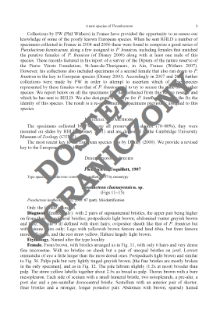- Search in all Repository
- Literature and maps
- Archeology
- Mills database
- Natural sciences
Advanced search
Advanced search
Advanced search
Advanced search
Advanced search

Object
Title: Life cycles of clausiliids of Poland - knowns and unknowns
Subtitle:
Annales Zoologici, vol. 58, no 4
Contributor:
Polska Akademia Nauk. Muzeum i Instytut Zoologii ; Fundacja "Natura optima dux"
Publisher:
Place of publishing:
Description:
Bibliogr. p. 879-880 ; P. 857-880 : ill. ; 27 cm ; Taxa in Latin
Type of object:
Abstract:
Among the 24 native clausiliids, 15 were subject to laboratory observations.Eleven of them were found to be oviparous, three – egg retainers and one – ovoviviparous. Batches, containing most often one to about a dozen of partly calcified, ellipsoidal orspherical eggs, appeared usually in the spring and autumn (in non-hibernating individualsthroughout the year). Probably the main factors determining the onset of reproduction arehumidity and temperature while the photoperiod has no significant effect. The incubation period is ca. two weeks (room temperature), the hatching is synchronous or asynchronous. Cases of intra-batch and inter-batch cannibalism were observed. The minimum time fromhatching/birth till adult size is ca. 3–9 months and after further 5–8 months the snails start producing eggs/babies. Clausiliids are iteroparous. Anatomical studies on the developmentof the reproductive system show that just before lip completion the reproductive system is still in completely developed. Penis, epiphallus and spermatheca develop within the firstmonth after growth completion (which would indicate attainment of ability to copulate), andthe reproductive system becomes wholly mature only after a few months. The clausiliid development strategy is probably the following: the quickest possible growth and attainment of adult size, then development of the reproductive system and attainment of sexual maturity.
Relation:
Volume:
Issue:
Start page:
End page:
Detailed Resource Type:
Format:
Resource Identifier:
Source:
MiIZ PAN, call no. P.255, vol 58, no 4 ; MiIZ PAN, call no. P.4314, vol 58, no 4 ; click here to follow the link
Language:
Language of abstract:
Rights:
Rights Reserved - Restricted Access
Terms of use:
Digitizing institution:
Museum and Institute of Zoology of the Polish Academy of Sciences
Original in:
Library of the Museum and Institute of Zoology of the Polish Academy of Sciences
Projects co-financed by:
Programme Innovative Economy, 2010-2014, Priority Axis 2. R&D infrastructure ; European Union. European Regional Development Fund
Access:
Object collections:
- Digital Repository of Scientific Institutes > Partners' collections > Museum and Institute of Zoology PAS > Scientific Journals
- Digital Repository of Scientific Institutes > Partners' collections > Museum and Institute of Zoology PAS > MIZ PAN Publications > Annales Zoologici
- Digital Repository of Scientific Institutes > Literature > Journals/Articles
Last modified:
Oct 2, 2020
In our library since:
May 5, 2016
Number of object content downloads / hits:
36
All available object's versions:
https://rcin.org.pl./publication/55796
Show description in RDF format:
Show description in RDFa format:
Show description in OAI-PMH format:
| Edition name | Date |
|---|---|
| Life cycles of clausiliids of Poland - knowns and unknowns / Maltz, Tomasz K. ; Sulikowska-Drozd, Anna | Oct 2, 2020 |
Objects Similar
Korniushin, Alexei V.
Norris, M. L. Adams, C. E.
Poliński, Władysław Karol Aleksander (1885–1930)
Poliński, Władysław Karol Aleksander (1885–1930)
Poliński, Władysław Karol Aleksander (1885–1930)
Ermilov, Sergej Gennad'evič Łochyńska, Małgorzata Olszanowski, Ziemowit
Korniushin, Alexei V.
Brooks, J. E. Htun, P. T.

 INSTYTUT ARCHEOLOGII I ETNOLOGII POLSKIEJ AKADEMII NAUK
INSTYTUT ARCHEOLOGII I ETNOLOGII POLSKIEJ AKADEMII NAUK
 INSTYTUT BADAŃ LITERACKICH POLSKIEJ AKADEMII NAUK
INSTYTUT BADAŃ LITERACKICH POLSKIEJ AKADEMII NAUK
 INSTYTUT BADAWCZY LEŚNICTWA
INSTYTUT BADAWCZY LEŚNICTWA
 INSTYTUT BIOLOGII DOŚWIADCZALNEJ IM. MARCELEGO NENCKIEGO POLSKIEJ AKADEMII NAUK
INSTYTUT BIOLOGII DOŚWIADCZALNEJ IM. MARCELEGO NENCKIEGO POLSKIEJ AKADEMII NAUK
 INSTYTUT BIOLOGII SSAKÓW POLSKIEJ AKADEMII NAUK
INSTYTUT BIOLOGII SSAKÓW POLSKIEJ AKADEMII NAUK
 INSTYTUT CHEMII FIZYCZNEJ PAN
INSTYTUT CHEMII FIZYCZNEJ PAN
 INSTYTUT CHEMII ORGANICZNEJ PAN
INSTYTUT CHEMII ORGANICZNEJ PAN
 INSTYTUT FILOZOFII I SOCJOLOGII PAN
INSTYTUT FILOZOFII I SOCJOLOGII PAN
 INSTYTUT GEOGRAFII I PRZESTRZENNEGO ZAGOSPODAROWANIA PAN
INSTYTUT GEOGRAFII I PRZESTRZENNEGO ZAGOSPODAROWANIA PAN
 INSTYTUT HISTORII im. TADEUSZA MANTEUFFLA POLSKIEJ AKADEMII NAUK
INSTYTUT HISTORII im. TADEUSZA MANTEUFFLA POLSKIEJ AKADEMII NAUK
 INSTYTUT JĘZYKA POLSKIEGO POLSKIEJ AKADEMII NAUK
INSTYTUT JĘZYKA POLSKIEGO POLSKIEJ AKADEMII NAUK
 INSTYTUT MATEMATYCZNY PAN
INSTYTUT MATEMATYCZNY PAN
 INSTYTUT MEDYCYNY DOŚWIADCZALNEJ I KLINICZNEJ IM.MIROSŁAWA MOSSAKOWSKIEGO POLSKIEJ AKADEMII NAUK
INSTYTUT MEDYCYNY DOŚWIADCZALNEJ I KLINICZNEJ IM.MIROSŁAWA MOSSAKOWSKIEGO POLSKIEJ AKADEMII NAUK
 INSTYTUT PODSTAWOWYCH PROBLEMÓW TECHNIKI PAN
INSTYTUT PODSTAWOWYCH PROBLEMÓW TECHNIKI PAN
 INSTYTUT SLAWISTYKI PAN
INSTYTUT SLAWISTYKI PAN
 SIEĆ BADAWCZA ŁUKASIEWICZ - INSTYTUT TECHNOLOGII MATERIAŁÓW ELEKTRONICZNYCH
SIEĆ BADAWCZA ŁUKASIEWICZ - INSTYTUT TECHNOLOGII MATERIAŁÓW ELEKTRONICZNYCH
 MUZEUM I INSTYTUT ZOOLOGII POLSKIEJ AKADEMII NAUK
MUZEUM I INSTYTUT ZOOLOGII POLSKIEJ AKADEMII NAUK
 INSTYTUT BADAŃ SYSTEMOWYCH PAN
INSTYTUT BADAŃ SYSTEMOWYCH PAN
 INSTYTUT BOTANIKI IM. WŁADYSŁAWA SZAFERA POLSKIEJ AKADEMII NAUK
INSTYTUT BOTANIKI IM. WŁADYSŁAWA SZAFERA POLSKIEJ AKADEMII NAUK


































